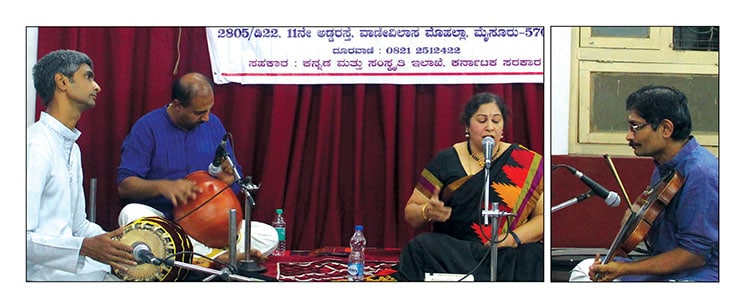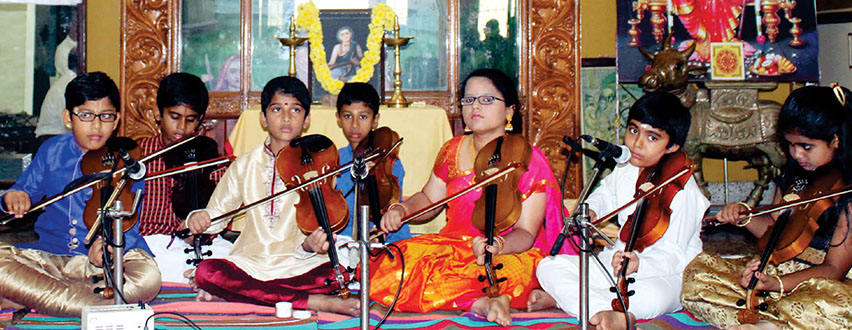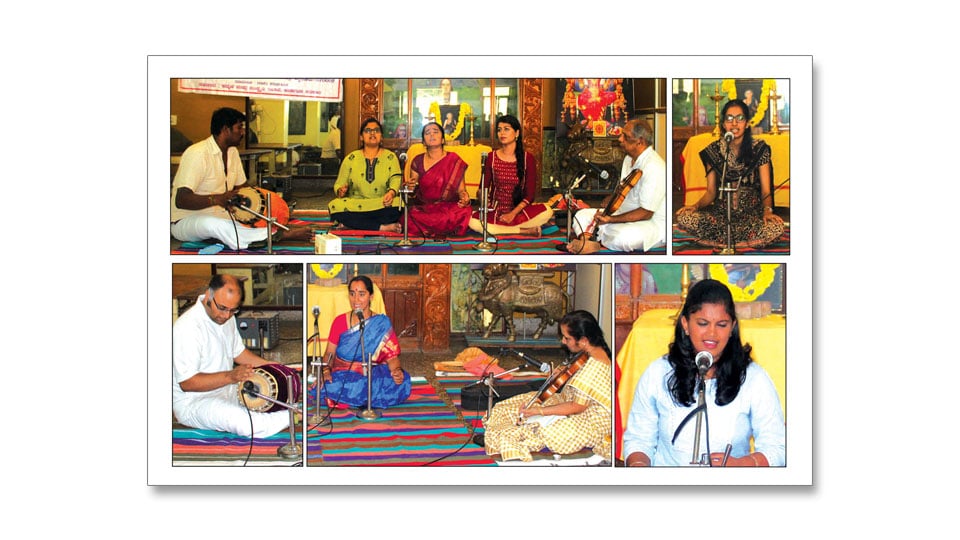By Dr. Rama V. Bennur
The Tyagaraja Sangeetha Sabha of Mysuru is unique in many ways. Without blowing any trumpets, it is quietly expressing its deep love for Kannada language which is certainly not restricted only to November! This Sabha too has been arranging its monthly music concerts like any other Sabhas. But behind it lies its love for the language and its service to Kannadigas.
The concerts arranged by Tyagaraja Sangeetha Sabha from day one, has been only by Kannadiga artistes! It has strictly followed this rule till today. Hence, whether the artistes reside in Karnataka or elsewhere in the world, they are welcome here. Another unique feature is celebrating Muthuswami Dikshitar’s Day. Celebrating Tyagaraja and Purandaradasa Aradhana is very common among musicians and Music Sabhas. But celebrating Dikshitar’s Day on the Amavasya of Deepavali is yet another practice they have strictly followed. (It was on the same day the great composer breathed his last.)

Young Vidushi M.R. Sudha sang on the 24th of October at Sri Rama Mandira, Jayanagar, under the aegis of Tyagaraja Sangeetha Sabha. She was accompanied by Vidwans C.N. Tyagaraju (violin), A. Radhesh (mridanga) and Raghunandan Vyasa Rao (ghata).
Sudha has imbibed good style of rendering kritis by her teacher Vidushi Gowri Kuppuswami. Invariably, a tinge of GNB baani can be traced in her singing. A good voice and sound knowledge of Tala boosts her singing.

A neat presentation of a Varna in Panthuvarali by Shatkaala Narasayya in two speeds gave a good start. ‘Vallabha nayakasya’ in Bhegade had a frill of crispy kalpana swaras. A neat delineation of Kharaharapriya by Sudha and Tyagaraju lead to the evergreen ‘Raama nee samaanamevaru’ by Tyagaraja. Yet another popular composition ‘Brovabaarama’ (Bahudhari) paved way to a soothing alapana of Hameer kalyani. Every phrase was emotionally charged in this heart touching raga. Swathi Tirunal’s ‘Gaangeya vasanadhara Padmanabha’ was a good choice. The kalpana swaras between the vocalist and violinist was enjoyable.
Raga Mohana was the main raga of the day. Sudha was at the peak of her manodharma.

Just the five notes of this Audava scale displayed many enchanting shades of the raga. Tyagaraja’s ‘Nannupaalimpa nadachi’ was presented in perfect tempo. The classic swaras that followed the neraval were excellent. Tyagaraju’s melodic violin support was commendable. Radhesh and Raghunandan’s percussive support was worth mentioning.
Muthuswami Dikshitar (1775-1835), one of the Trinities of Indian music, is considered as one of the best composers of classical music. He was a great Veena player, poet, singer, philosopher and a Sanskrit scholar. All these qualities are evident in his compositions. His father Ramaswami Dikshitar too was a scholar and a composer. After Sri Chidambaranatha Yogi took Dikshitar under his wings, his life took a different turn. At Benaras, Muthuswami Dikshitar was exposed to Hindustani music, which would influence his compositions later.
Under the pen name of ‘Guruguha,’ Dikshitar composed a number of compositions. It is said that he was the first to introduce ‘Samashti charana’ kritis. His clusters of compositions like Kamalamba Navavarana, Navagraha Kritis and Neelotpalamba Kritis speak volumes of his mastery on many subjects like Advaitha philosophy, Tantra, Mantra, Jyotishya shastra and Sanskrit language. Many of his compositions describe in detail the different deities. Mastering his composition is a challenge for learners.

Dikshitar breathed his last on the amavasya day of Deepavali. Thus, ‘Guruguha Jayanti’ is observed on that day. In Mysuru, Sri Tyagaraja Sangeetha Sabha is one which celebrates that along with all the musicians of the city. On the 28th of October, young and senior artistes flocked together at the Prarthana Mandira of Sri Chandramouleeshara Temple to offer individual seva after which, they all sang the Navavarana Kritis of Dikshitar.
This year too Musicians like H.K. Narasimhamurthy, G.S. Ramanujam, V.S. Ramesh, N. Srinath, Manasa Nayana, A. Radhesh, Saishivu, M.K. Saraswathi, Dr. R.N. Srilatha, Koviladi Kala, Rajalakshmi, Rajalakshmi Sridhar, M.R. Sudha and many more joined in paying tributes to the great composer.








In this Diskhitar’s day, Vidushi Sudha’s katcheri also inluded a few Thyagaraja kitis! Why did this artist not select all Dikshitar’s compositions?
Much has been made of Mrs Gowri Kuppuswami’s lineage to GNB. She was not I heard from people in Chennai, a prominent disciple of GNB like Late MLV or even Radha Jayalakhmi. Well, GNB bani mainly was heavy use of ‘birkas’, and fast rendering of kritis tinged with laya. I understood. When talking about the ‘tinge of GNB’, better to be specific. Otherwise, the report becomes mundane.
@strangeworld I agree that on Dikshitar’s day,this vidushi mixing Thyagaraja kritis with a sprinkling of Dikshitar’s kritis was indeed a sacrilege. It clearly reveals that this vidushi did not know enough of Dikshitar;s kritis to fill in the katcheri time. Versatile artists lik D K Pattammal would have done i quite easily as the fore meost exponent of Dikshitar’s compositions.
As for GNB and his ‘bani’, one could immediately get it from MLV, Radha Jayalakshmi ( who it appears Chowdiah called as ‘GNB in sarees’. Chowdiah knew GNB more than any one, and supported GNB when he got flak from jealous colleagues , because GNB was almost self-made artist, one of a kind), Kalayanaraman and Ramachandran. It was well known that GNB let his disciples to teach those others aspirants, and any claim of lineage by Mrs Kuppuswami can only be just that. That was the fact.